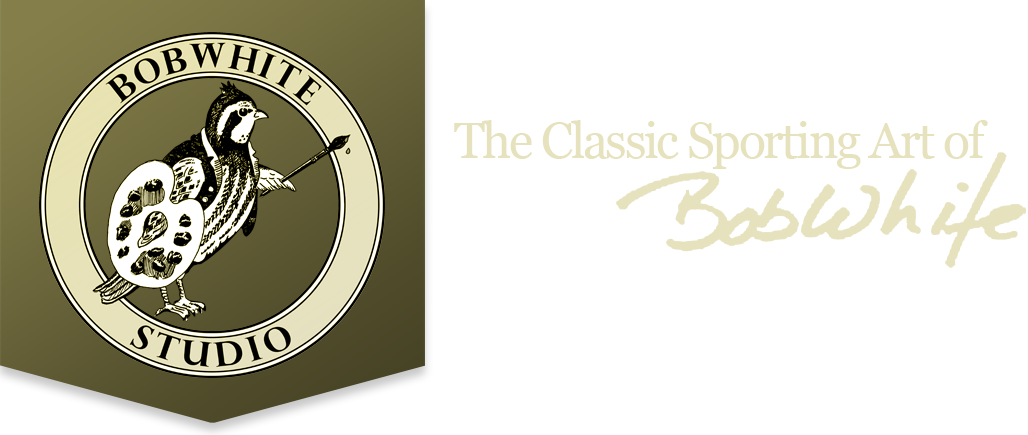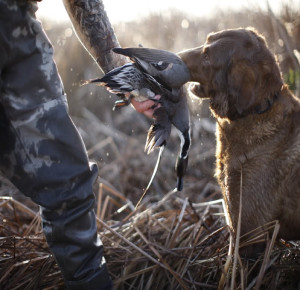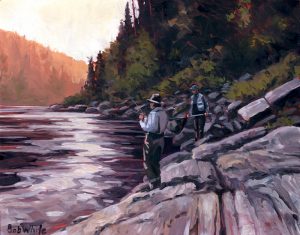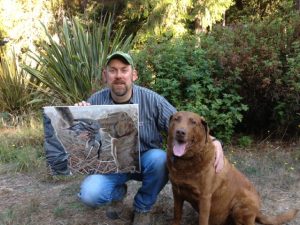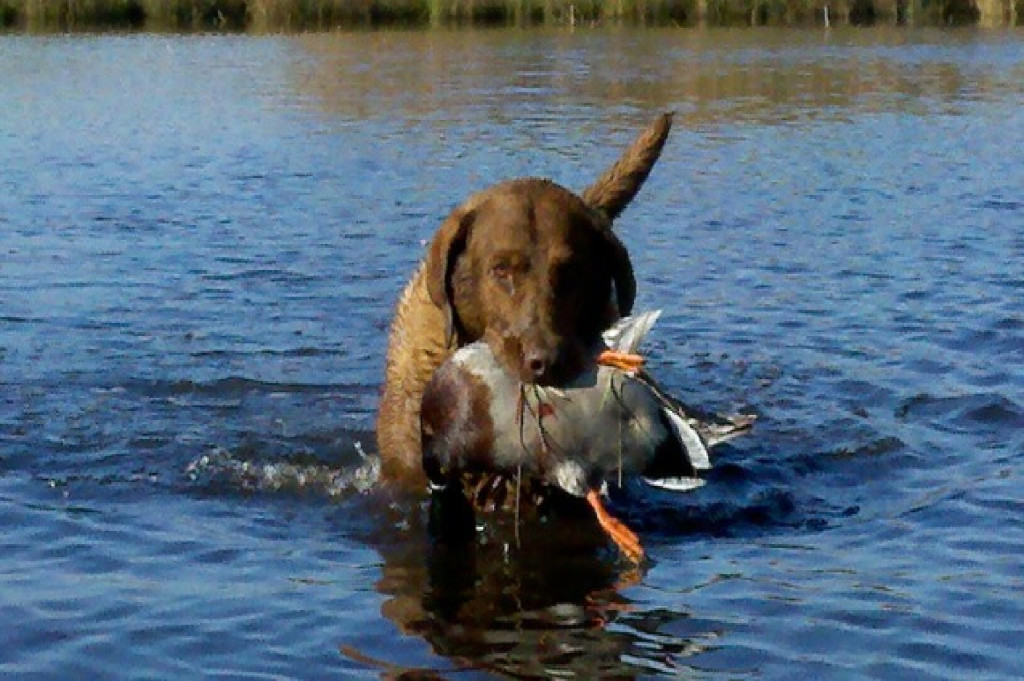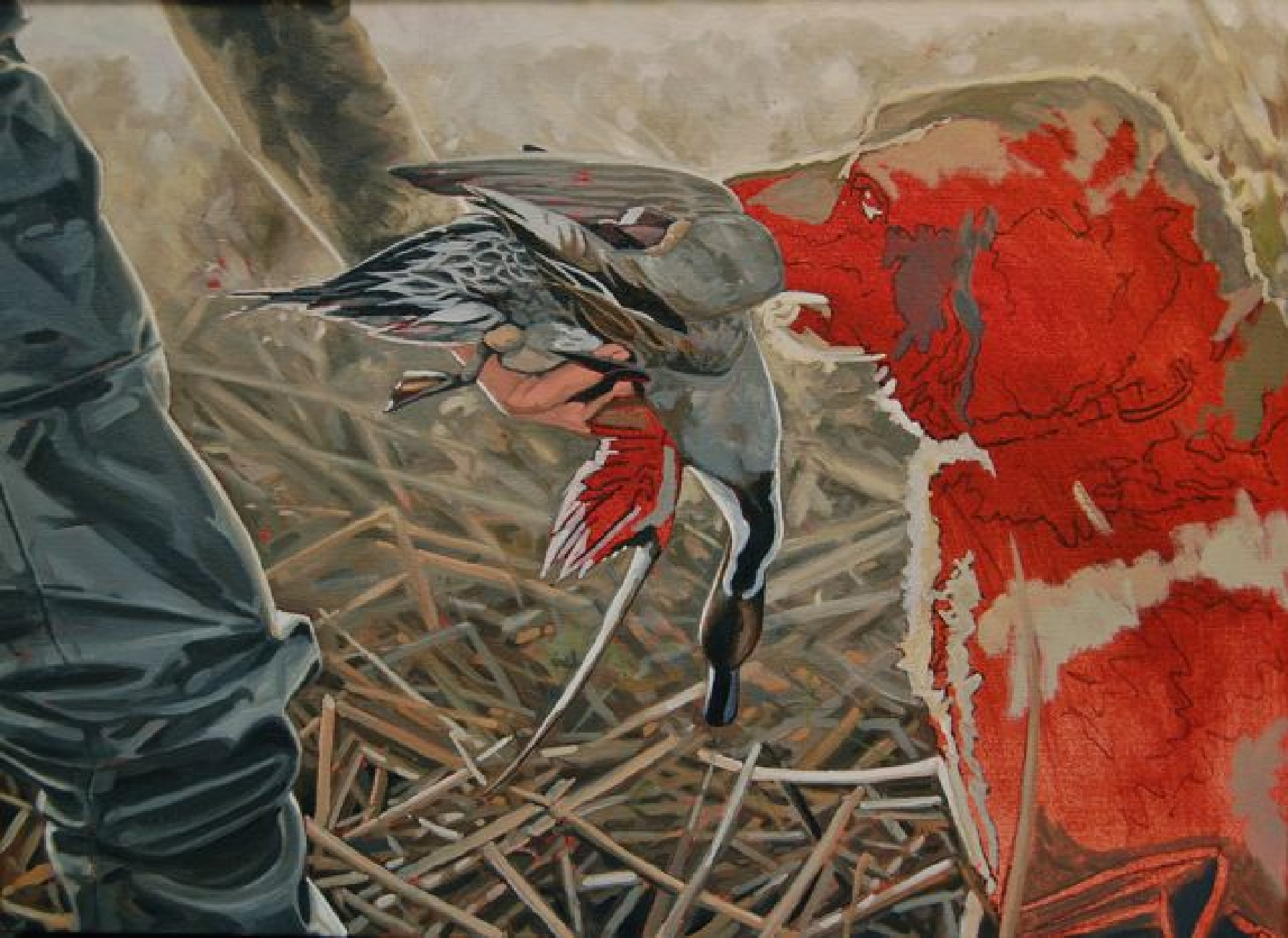
I hang out on an internet fly fishing board that has a whole lot more going on than the latest recipe for tying wooly buggers. You’re as likely to read a tutorial about properly smoking a pork shoulder, or perhaps, how carve a set of diver decoys, as you are to read a report about someone’s latest fishing trip.
The guys that hang out there are an odd group of miscreants, and I’m proud to be part of the mix. There are plenty of differing points of view, especially about politics, and the best ways to catch a fish, but there are some things that are held sacred… including family, kids, and especially… dogs.
There’s also an amazing amount of talent represented on the board; artists, writers, musicians, fly tyers, and photographers, are just some of the artists that hang out there. One of the members is a very talented photographer, and I was blown away by some of his duck hunting images. When I asked him if I might paint from his work should the opportunity ever present itself, he very graciously consented.
A few weeks later, I received a column from Joe Arnette, who writes the closing column in Gun Dog magazine. It seemed to have been written for one of my favorite images by Gregg Holland.
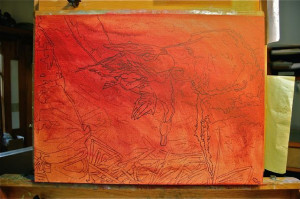 The next day, the canvas was stretched, primed, and a ground of alizarin crimson and yellow ochre was applied. The following morning my pallet was mixed, and I was ready to have some fun!
The next day, the canvas was stretched, primed, and a ground of alizarin crimson and yellow ochre was applied. The following morning my pallet was mixed, and I was ready to have some fun!
I decided it would be fun to record the process of painting “Cal the Chessie” and share those steps with my buddies on the board. Here’s an edited version of those posts.
Session One
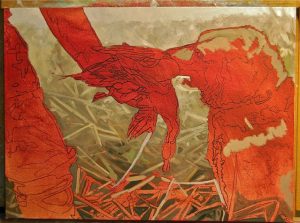 The beginning a painting is like a first date; there’s something you like and find attractive, but you really don’t know anything substantive. So, you begin the process of exploration and learning. One starts with a comment, a brush stroke of color… is it the right color? Who knows, but you have to start somewhere. As one adds to the conversation you listen with an inner ear for some clue of where to go next.
The beginning a painting is like a first date; there’s something you like and find attractive, but you really don’t know anything substantive. So, you begin the process of exploration and learning. One starts with a comment, a brush stroke of color… is it the right color? Who knows, but you have to start somewhere. As one adds to the conversation you listen with an inner ear for some clue of where to go next.
You have to make judgments; did she respond positively to that last remark? If so, you build upon it… but not too much, that would be repetitive and boring. Maybe a joke; a splash of color that doesn’t belong. Did she laugh… maybe lean into you? Has she begun to give you clues about where to go next… is she flirting and gently leading the conversation?
Okay, you’ve established the beginning of the relationship by painting in some background. Background information is always a safe place to start… but the relationship needs to go to the next step, and all the aspects of this liaison need to be brought foward together, otherwise it will be flat and one dimensional; elements out of balance.
One needs to take risks. Your knee brushes against hers; you’ve added color to more than just background. Did it feel right? Did she respond? How far does one go on a first date?
Session Two
One of my friends on the board asked why I paint the canvas in red and orange first… and I replied that the rust colored under-painting is an old technique, one that I’d read about for years, but had never tried. My good friend, the painter Rick Harrington, left me with some prepared panels when he visited Bristol Bay Lodge a couple of summers ago, and they had a bright orange ground on them. Earlier this spring I was in a funk, feeling stale and programmed, and pick one up and did a painting on it. Wow… it was really fun to learn something new and add an aspect to my work that never existed before. Instead of painting “up to the edge” I now let it go, and painted less precisely. This allows bits of the under-painting to show through. The resulting bits of color shimmer and cause the paint next to them (particularly if they’re complimentary) to vibrate, adding an inner-life to the work.
“Dusk on the Adlatok River” is an example of what I mean to accomplish.
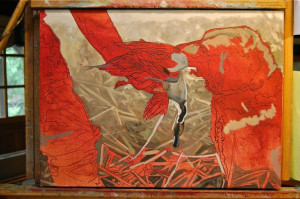 The second date is always an interesting one… this is when one gets to see if she lives up to your memory of her. This is usually when you notice that big mole on her chin… how did you miss that? It probably, happened because you had your attention on other more intriguing aspects of her personality.
The second date is always an interesting one… this is when one gets to see if she lives up to your memory of her. This is usually when you notice that big mole on her chin… how did you miss that? It probably, happened because you had your attention on other more intriguing aspects of her personality.
After being away from one another, it takes a little work to become reacquainted. So, you begin by revisiting the ground you’ve already covered. I’ll start by fussing with some background elements until I’ve re-established a dialog. Once we’re communicating I’ll take it to the next level.
The background is meaningless without the development of other key elements. It’s been difficult to figure out the values of the background without something in the foreground with which to compare them to. So, I’ve jumped to the pintail. My goal is to have color and correct values established by the end of this date.
Session Three
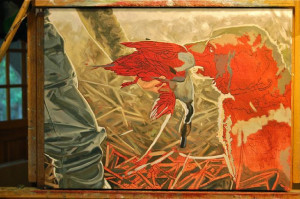 Things progressed nicely on the third date. The more serious the dialog one explores, the more important, and in-sync the unspoken language becomes. It’s in these moments, when magic happens, that I try to disconnect thinking from the act of painting. I simply try to stay out of the way. I try to remember that I’m simply along for the ride and most decisions will be communicated to me by the painting.
Things progressed nicely on the third date. The more serious the dialog one explores, the more important, and in-sync the unspoken language becomes. It’s in these moments, when magic happens, that I try to disconnect thinking from the act of painting. I simply try to stay out of the way. I try to remember that I’m simply along for the ride and most decisions will be communicated to me by the painting.
It’s not the most productive way to paint, I suppose. I find myself free-mixing paint intuitively and without a conscious plan. It makes a lot more sense to “paint” on the palette first, with established mixes of color and value. A lot of time and paint gets wasted when you paint on the canvas first… but that’s where we were today.
I’d hoped to have the entire canvas covered in paint by quitting time, but the process of completing a painting always moves at its own pace. As it is, I’ve finished the waders, the extended arm, and have the hand blocked in. As the other elements come together the background has begun to make more sense; it feels good. There’ll be adjustments along the way, as the elements begin to communicate with one another. The goal now is to not get hung up with the details, and remain loose and painterly.
Time for a bike ride to clear the turpentine fumes from my head.
Session Four
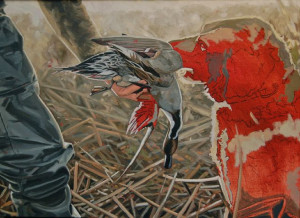 Our last date went on for most of the night, and I was too spent afterwards to report in with an update. My shoulders are so knotted up from standing in front of the easel that I feel like I have a grapefruit between my shoulder blades.
Our last date went on for most of the night, and I was too spent afterwards to report in with an update. My shoulders are so knotted up from standing in front of the easel that I feel like I have a grapefruit between my shoulder blades.
This painting, like some relationships, has demanded more from me than I thought it would. It’s really challenged me to remain loose and painterly. The reeds in the foreground seemed to take forever, mostly because I was determined not to get all hung up on the detail and simply paint the effect of light on them. I think they read well… good enough to move on. I’ll come back and revisit them if I need to.
How do you remain loose and paint a drake pintail? Heck, if I know… but I’m attempting to balance any detail I paint into the plumage with loose brush stokes elsewhere, when and where I can; in the breast and upper wing, etc.
I was lying in bed this morning, waking up and thinking about the painting, when I remembered a story about John Singer Sargent. Sargent had struggled with a particularly difficult passage on a portrait for three full days before he finally got the effect he wanted. At the end of that day, much to the astonishment of his assistant, he scraped off all of the work. When the assistant asked, why, he replied that it had taken him three days to figure it out, and now that he’d done so, he’d come back in the morning and do it again in a few hours, and it’d be fresh and painterly.
Wow… that takes some kind of confidence and courage! I’m happy when I finally get it right. I guess that’s the difference between being good and great.
Today, I hope to finish the duck and move on to Cal, the Chessie.
More to come…
Session Five
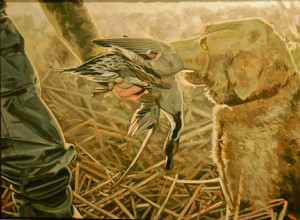 It was a great date. I was able to finish the drake pintail, bring the value of the background into the ball park, and get Cal the Chessie blocked in.
It was a great date. I was able to finish the drake pintail, bring the value of the background into the ball park, and get Cal the Chessie blocked in.
I struggled with the hand, holding the bird… the value seemed way too light compared to other objects, especially as back-lit as the image is… then it occurred to me that Gregg Holland, the photographer, probably used some fill-in flash to balance the light and not loose detail. I dialed the values back a few notches… and then one more. I think it’s about right. I can feel the weight of the bird when I look at the painting, now… and, that’s what I’m shooting for.
With any luck, I’ll finish the painting tomorrow, and than give it a one or two day break to forget about it. When we next see each other, it will be like that gal you used to have a lot of fun with… and haven’t seen in a long while. When she walks in the bar after a few months… you’ll either fall off your stool, or wonder what the heck you saw in her.
Luckily, I can make whatever changes I want to the painting… which is nice.
Session Six
It’s been a long day of back and forth… our first argument, so to speak.
I’m not sure who won; heck I’ve forgotten what we were fighting over. Maybe we both sensed our time together was coming to an end and we began to pull back from one another.
There’ll probably be some fine-tuning, but for now I’m ready to move on.
Over the course of posting the painting process, Matt Greene, the owner of Cal the Chessie, contacted me and he asked about purchasing the painting. What he didn’t know was that his father-in-law had already made arrangements to acquire it, and present to Matt as a gift.
The gift was made even more poignant because Cal had hunted his last season; the eleven-year old veteran was to be retired.
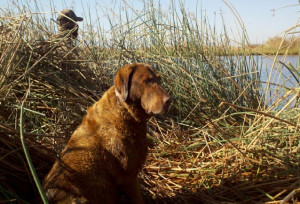 Just recently, I heard from Matt that Cal was to be pushed into service one last season. “He had a great time,” Matt reported. “We ended the opening weekend with a limit of ducks both days, and 3 geese. It was a great way to start the season. One thing I know for sure; they may get old, and they may get slower, but they never lose their drive to retrieve and please. Starting last week when Cal saw the hunting gear being pulled out of the closet and piled by the door, he went nuts! Since the first weekend, he hasn’t moved ten feet from me, other than to eat or go pee. He’s happy as hell.”
Just recently, I heard from Matt that Cal was to be pushed into service one last season. “He had a great time,” Matt reported. “We ended the opening weekend with a limit of ducks both days, and 3 geese. It was a great way to start the season. One thing I know for sure; they may get old, and they may get slower, but they never lose their drive to retrieve and please. Starting last week when Cal saw the hunting gear being pulled out of the closet and piled by the door, he went nuts! Since the first weekend, he hasn’t moved ten feet from me, other than to eat or go pee. He’s happy as hell.”
The painting of Cal the Chessie has been presented to Ducks Unlimited for inclusion in the national banquet selection. Wish us luck!
